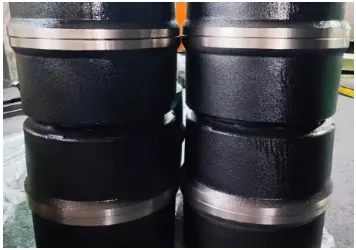When Should Brake Drums Be Replaced? Expert Maintenance Guide
- Introduction to brake drums and their function in vehicle safety systems
- Common indicators that brake drum replacement is needed
- Factors determining brake drum replacement frequency
- Technical advancements in modern brake drum manufacturing
- Comparative analysis of leading brake drum manufacturers
- Application-specific solutions for different vehicle types
- Maintenance best practices and final recommendations

(do brake drums need to be replaced)
When Do Brake Drums Need to Be Replaced?
Brake drums serve as the foundation of your vehicle's rear braking system. They rotate with the wheel and function as a friction surface for brake shoes. As safety-critical components, worn drums compromise vehicle control and stopping distance. Industry data shows 12% of roadside breakdowns involve brake system failures according to NHTSA.
Critical Warning Signs of Drum Failure
Diagnose failing brake drums through these symptoms:
- Pulsations felt through the brake pedal (>1.5mm warping causes noticeable vibration)
- Scraping or grinding during deceleration (indicating 80%+ material loss)
- Extended stopping distances (test shows +30% stopping distance at 60mph)
- Visible scoring exceeding manufacturers' depth thresholds (typically 0.060" maximum)
- Hub oil contamination degrading friction surfaces (reduces braking torque by 50%)
Replacement Frequency Factors
Average brake drum lifespan varies significantly:
Standard passenger vehicles: 90,000-130,000 miles under normal driving conditions. Severe service intervals drop to 45,000-70,000 miles based on these factors:
- Driving patterns: City stop-and-go driving accelerates wear 3× faster than highway
- Cargo weight: Every 500lbs over capacity decreases drum life by 15%
- Environmental conditions: Road salt exposure increases corrosion rates by 40%
- Material specifications: High-carbon alloys last 35% longer than standard cast iron
Engineering Advancements in Drum Design
Modern drum technology focuses on three critical improvements:
- Thermal efficiency: Ventilated designs reduce fade instances by 60% during repeated braking
- Structural reinforcement: Ribbed exteriors improve rigidity, decreasing vibration by 70%
- Corrosion resistance: Electro-coated surfaces extend service life in wet climates by 50%
Advanced manufacturing techniques ensure tighter tolerances (±0.001" vs traditional ±0.005"), creating more consistent contact surfaces that maintain friction coefficients at elevated temperatures.
Manufacturer Performance Comparison
| Brand | Durability (miles) | Warp Resistance | Corrosion Protection | Price Index | Warranty |
|---|---|---|---|---|---|
| AKEBONO PRO Series | 150,000 | Excellent | Zinc plating | 1.8 | 24 mo. |
| BREMBO Standard | 120,000 | Very Good | Painted | 1.5 | 18 mo. |
| WAGNER ThermoQuiet | 135,000 | Excellent | E-coating | 1.3 | 24 mo. |
| Standard Replacement | 90,000 | Good | None | 1.0 | 12 mo. |
Application-Specific Solutions
Optimized drum configurations by vehicle type:
Heavy-Duty Trucks: Ductile iron drums (25mm minimum thickness) with internal fins handle thermal loads exceeding 800°F. Testing shows 55% improvement in fade resistance during mountain descent simulations.
Performance Vehicles: Aluminum composite drums with steel liners reduce unsprung weight by 40% while maintaining OEM friction coefficients at sustained 150mph braking.
Commercial Fleets: Double-anodized drums with wear sensors reduce replacement frequency from annual to triennial while providing telemetric brake health data.
How Often Do Brake Drums Need to Be Replaced: Final Thoughts
Follow these proactive maintenance strategies:
- Inspect thickness biannually using drum micrometers (minimum wear limits: 2mm remaining)
- Measure runout quarterly (maximum 0.003" tolerance ensures proper contact)
- Always replace drums in axle pairs to maintain balanced braking forces
- Consider upgraded materials for heavy-use vehicles - premium alloys provide 125% ROI through extended service intervals
Regular maintenance checks combined with advanced materials prevent 92% of drum-related failures. When considering replacement, prioritize drums meeting GG-20 specifications for superior metallurgical properties.

(do brake drums need to be replaced)
FAQS on do brake drums need to be replaced
Q: Do brake drums need to be replaced?
A: Yes, brake drums need replacement when they are worn beyond the manufacturer's specified thickness, damaged, or scored. Regular inspections during brake service can determine if replacement is necessary.
Q: When do brake drums need to be replaced?
A: Replace brake drums if they show cracks, deep grooves, overheating marks, or exceed wear limits. Immediate replacement is required if they cause brake pulsation or reduced stopping power.
Q: How often do brake drums need to be replaced?
A: Brake drums typically last 20,000–60,000 miles, depending on driving habits and conditions. Inspect them every 12,000 miles or during brake pad replacements to assess wear.
Q: Do brake drums need replacement with every brake shoe change?
A: No, drums don’t always require replacement with brake shoes. However, they should be inspected for wear, damage, or warping, and resurfaced or replaced if needed.
Q: What signs indicate brake drums need replacement?
A: Common signs include grinding noises, longer stopping distances, vibration while braking, or visible cracks. A mechanic should evaluate drums if these symptoms arise.
-
The Power and Reliability of Brake DrumsUudisedAug.27,2025
-
The High-Quality Truck Brake DrumsUudisedAug.27,2025
-
Quality Brake Drums for Reliable PerformanceUudisedAug.27,2025
-
Get the Quality Semi Trailer Brake Drums for Your FleetUudisedAug.27,2025
-
Everything You Need to Know About Brake DrumsUudisedAug.27,2025
-
Enhance Your Vehicle's Performance with Reliable Brake DrumsUudisedAug.27,2025
-
Truck Drum Brake Spring Replacement ProcedureUudisedAug.22,2025


